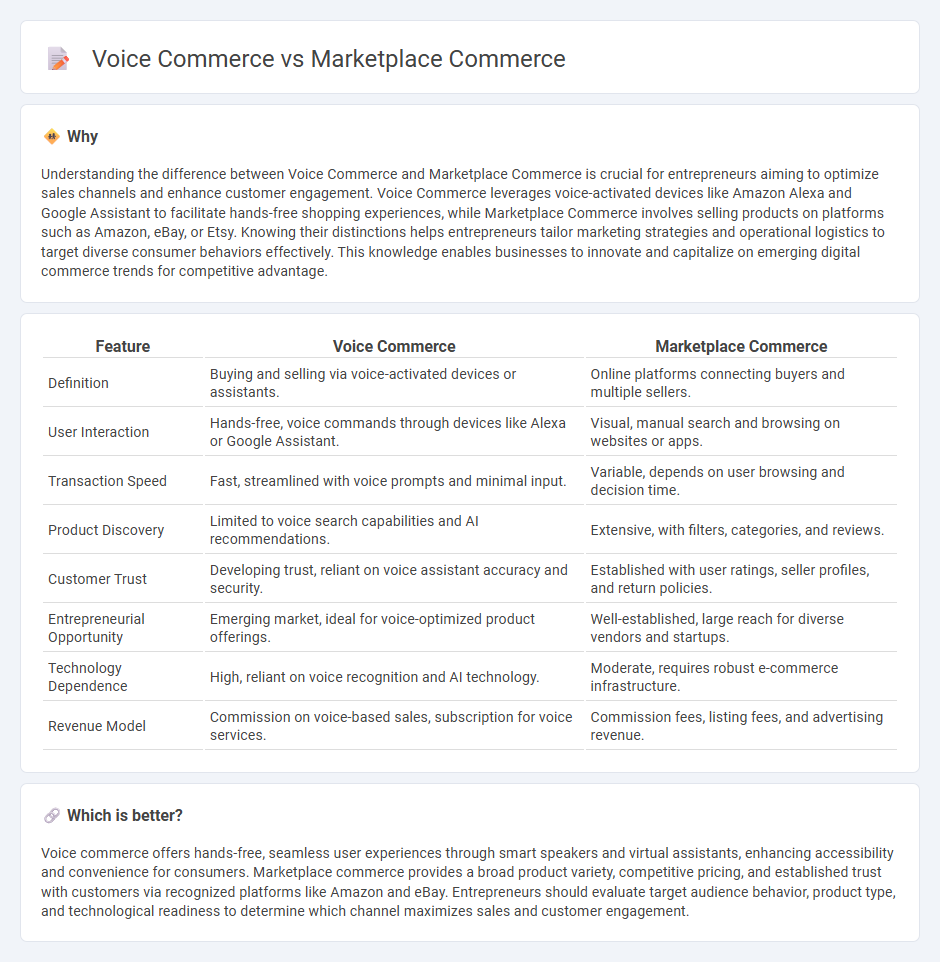
Voice commerce leverages speech recognition technology to enable consumers to purchase products through voice commands, offering a hands-free and personalized shopping experience. Marketplace commerce involves multiple vendors selling goods on a centralized platform, providing a wide product selection and competitive pricing. Explore the differences between these innovative commerce models to understand which best suits your entrepreneurial goals.
Why it is important
Understanding the difference between Voice Commerce and Marketplace Commerce is crucial for entrepreneurs aiming to optimize sales channels and enhance customer engagement. Voice Commerce leverages voice-activated devices like Amazon Alexa and Google Assistant to facilitate hands-free shopping experiences, while Marketplace Commerce involves selling products on platforms such as Amazon, eBay, or Etsy. Knowing their distinctions helps entrepreneurs tailor marketing strategies and operational logistics to target diverse consumer behaviors effectively. This knowledge enables businesses to innovate and capitalize on emerging digital commerce trends for competitive advantage.
Comparison Table
| Feature | Voice Commerce | Marketplace Commerce |
|---|---|---|
| Definition | Buying and selling via voice-activated devices or assistants. | Online platforms connecting buyers and multiple sellers. |
| User Interaction | Hands-free, voice commands through devices like Alexa or Google Assistant. | Visual, manual search and browsing on websites or apps. |
| Transaction Speed | Fast, streamlined with voice prompts and minimal input. | Variable, depends on user browsing and decision time. |
| Product Discovery | Limited to voice search capabilities and AI recommendations. | Extensive, with filters, categories, and reviews. |
| Customer Trust | Developing trust, reliant on voice assistant accuracy and security. | Established with user ratings, seller profiles, and return policies. |
| Entrepreneurial Opportunity | Emerging market, ideal for voice-optimized product offerings. | Well-established, large reach for diverse vendors and startups. |
| Technology Dependence | High, reliant on voice recognition and AI technology. | Moderate, requires robust e-commerce infrastructure. |
| Revenue Model | Commission on voice-based sales, subscription for voice services. | Commission fees, listing fees, and advertising revenue. |
Which is better?
Voice commerce offers hands-free, seamless user experiences through smart speakers and virtual assistants, enhancing accessibility and convenience for consumers. Marketplace commerce provides a broad product variety, competitive pricing, and established trust with customers via recognized platforms like Amazon and eBay. Entrepreneurs should evaluate target audience behavior, product type, and technological readiness to determine which channel maximizes sales and customer engagement.
Connection
Voice commerce leverages voice-activated devices to enable seamless shopping experiences, directly integrating with marketplace commerce platforms that host diverse product listings and sellers. Entrepreneurs harness this connection to expand customer reach and simplify purchasing processes, driving higher engagement and sales across multiple marketplaces. The synergy between voice recognition technology and marketplace ecosystems transforms traditional e-commerce by providing hands-free, personalized shopping solutions that cater to evolving consumer behaviors.
Key Terms
Platform Integration
Marketplace commerce relies on robust platform integration to seamlessly connect sellers, buyers, and payment systems within a centralized digital environment, enhancing user experience and transaction efficiency. Voice commerce, powered by AI-driven voice assistants, emphasizes real-time natural language processing integration to enable hands-free shopping across various smart devices. Explore the evolving dynamics and technical strategies behind these commerce platforms to optimize your business ecosystem.
User Experience
Marketplace commerce offers a visually rich, multi-seller environment where users can compare products, read reviews, and interact with detailed images for informed decision-making. Voice commerce streamlines purchasing through hands-free voice commands, enabling quick, conversational transactions especially suited for on-the-go users or accessibility needs. Explore how these platforms optimize user experience and drive engagement by integrating convenience and interaction.
Transaction Method
Marketplace commerce relies on digital platforms where buyers and sellers engage through visual interfaces, often utilizing search filters and product reviews to complete transactions. Voice commerce enables consumers to make purchases using voice commands via smart speakers or mobile assistants, streamlining the transaction process with natural language understanding and hands-free operation. Discover how these distinct transaction methods shape the future of online shopping experience.
Source and External Links
Adobe Commerce Marketplace - A platform offering thousands of free and premium Magento extensions and themes to extend online store functionality.
Adobe Commerce Marketplace - Experience League - An application store featuring a curated selection of vetted extensions for merchants, providing quality assurance and developer tools for building commerce solutions.
Commerce Marketplace - Salesforce Help - Guidance on integrating the Commerce Marketplace app with Salesforce Commerce storefronts, including setup of page layout and permissions.
 dowidth.com
dowidth.com